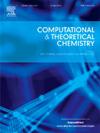Light-induced sensing characteristics of Silicene nanoribbon based device: a first-principles study
IF 3
3区 化学
Q3 CHEMISTRY, PHYSICAL
引用次数: 0
Abstract
A major drawback of traditional sensors is their sluggish recovery time, which hinders their use in real-time sensing applications. This study introduces a novel optoelectronic approach for benzene (C6H6) detection using armchair and zigzag silicene nanoribbons (ASiNR and ZSiNR) under varying photon energies (0–5 eV) to investigate the electronic, charge transport and photo response behavior, via first-principles density functional theory (DFT) and non-equilibrium Green's function (NEGF) formalism. Our findings reveal that the hydrogen-edge passivated ASiNR and ZSiNR exhibit semiconducting and quasi-metallic band structures respectively. Upon benzene adsorption, the electronic and transport properties of silicene nanoribbons undergo significant modulation, resulting in substantial conductivity changes, as confirmed by I-V characteristics and transmission spectra. The strong adsorption energy of benzene (up to −0.93 eV for ASiNR and −0.87 eV for ZSiNR in the dark) ensures stable detection. At the same time, UV irradiation drastically reduces recovery times by up to 99.9 %, enabling rapid sensor regeneration. Furthermore, ZSiNR exhibits superior photocurrent response, making it a highly efficient candidate for optoelectronic VOC sensing. These results establish silicene nanoribbons as promising platforms for next-generation gas sensors, leveraging photon-assisted mechanisms for ultra-sensitive and highly responsive VOC detection at sub-ppb concentrations.

基于硅纳米带器件的光致传感特性:第一性原理研究
传统传感器的一个主要缺点是恢复时间慢,这阻碍了它们在实时传感应用中的应用。本研究介绍了一种新的光电检测方法,利用不同光子能量(0-5 eV)下的armchair和zigz型硅纳米带(ASiNR和ZSiNR)检测苯(C6H6),通过第一性原理密度泛函理论(DFT)和非平衡格林函数(NEGF)形式主义研究电子、电荷输运和光响应行为。结果表明,氢边钝化的ASiNR和ZSiNR分别表现出半导体和准金属带结构。吸附苯后,硅烯纳米带的电子和输运性质发生了明显的调制,导致电导率发生了很大的变化,这可以通过I-V特性和透射光谱来证实。苯的强吸附能(ASiNR为- 0.93 eV, ZSiNR为- 0.87 eV)确保了稳定的检测。同时,紫外线照射大大减少了高达99.9%的恢复时间,实现了传感器的快速再生。此外,ZSiNR表现出优异的光电流响应,使其成为光电VOC传感的高效候选材料。这些结果表明,硅纳米带是下一代气体传感器的有前途的平台,利用光子辅助机制在亚ppb浓度下进行超灵敏和高响应的VOC检测。
本文章由计算机程序翻译,如有差异,请以英文原文为准。
求助全文
约1分钟内获得全文
求助全文
来源期刊

Computational and Theoretical Chemistry
CHEMISTRY, PHYSICAL-
CiteScore
4.20
自引率
10.70%
发文量
331
审稿时长
31 days
期刊介绍:
Computational and Theoretical Chemistry publishes high quality, original reports of significance in computational and theoretical chemistry including those that deal with problems of structure, properties, energetics, weak interactions, reaction mechanisms, catalysis, and reaction rates involving atoms, molecules, clusters, surfaces, and bulk matter.
 求助内容:
求助内容: 应助结果提醒方式:
应助结果提醒方式:


